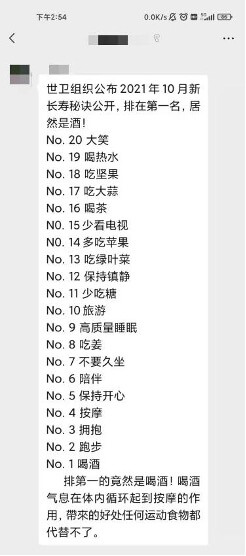Publish Date (HKT) 2021-12-08
[FALSE] Does alcohol rank first in ‘the habits to longevity’ list released in October 2021 by WHO?

Screenshot of the message circulating in WeChat groups.
The Claim and Our Verdict
- The claim: A message circulating in WeChat groups claims that alcohol ranks first in “the list released in October 2021 by World Health Organization (WHO).
- Fact-checking:
- WHO has never released a list titled “the habits to longevity.”
- A report published in 2007 by the International Agency for Research on Cancer (IARC), an intergovernmental organization which was a part of WHO, has concluded that alcoholic beverages are carcinogenic to humans (Group1).
- Since the harmful use of alcohol brings significant social and economic losses to individuals and society at large, WHO member states negotiated and agreed upon the “Global strategy to reduce the harmful use of alcohol” in 2010.
- Our ruling: Therefore, we rate the claim as FALSE.
News Brief
Recently, a message circulating in WeChat groups claims that “the habits to longevity” list was released by the WHO in October 2021, which included 20 items such as “laughing out loud” and “drinking tea.” In the ranking list, the first one is “drinking alcoholic beverages.” The message also promotes the benefits of drinking alcohol and claims that alcohol can boost the body’s circulation.
Fact-checking
A keyword search did not find any information related to the purported “habits to longevity” list published by the WHO. However, a section of the 2021 World Health Statistics report published by the WHO introduces and evaluates the global “Harmful use of alcohol” in the past few years. The report contains five sections, i.e., “Healthy life expectancy and burden of disease,” “Risks to health,” “Universal health coverage,” and “Accelerating progress towards health-related SDGs and Triple Billion targets.” A keyword search on “alcohol” in the report also did not produce any content related to the claim. The report states that the global annual consumption of alcohol was equivalent to 5.8 litres (UI 5.5 to 6.2) of pure alcohol per capita (persons aged 15 and above). The WHO regions with the highest consumption were the European region, the region of the Americas, and the Western Pacific region.
International Agency for Research on Cancer (IARC), the intergovernmental agency that is part of the WHO, published a report about consumption of alcoholic beverages. The report presented and analyzed the carcinogenicity data from human and animals, and then drew the conclusion that alcoholic beverages are carcinogenic to humans (Group1). It adds that the occurrence of malignant tumours of the oral cavity, pharynx, larynx, oesophagus, liver, colorectum and female breast is causally related to the consumption of alcoholic beverages.
WHO also published several articles concerning the harmful use of alcohol, including “Harmful use of alcohol increases the risk of breast cancer,” “Harmful use of alcohol kills more than 3 million people each year, most of them men.” On Sept. 21, 2018, the WHO published the fact sheet of alcohol. It claimed that the harmful use of alcohol can cause diseases, injuries, disabilities and deaths to individuals, and brings significant social and economic losses to individuals and society at large. Therefore, WHO member states negotiated and agreed to the “Global strategy to reduce the harmful use of alcohol” in 2010. The second draft of global alcohol action plan was released Oct. 4, 2021.
Conclusion
Therefore, we rate the claim as FALSE.
References
- WHO, “2021 World Health Statistics,” May 13, 2021.
- The International Agency for Research on Cancer, “Consumption of alcoholic beverages,” archived Dec. 7, 2008.
- WHO, “Breast Cancer,” March 26, 2021.
- WHO, “Harmful use of alcohol kills more than 3 million people each year, most of them men,” Sept. 21, 2018.
- WHO, “Alcohol,” Sept. 21, 2018.
- WHO, “Global alcohol action plan: Second draft, unedited,” Oct. 4, 2021












 :
:  : 3411 7375
: 3411 7375 :
: